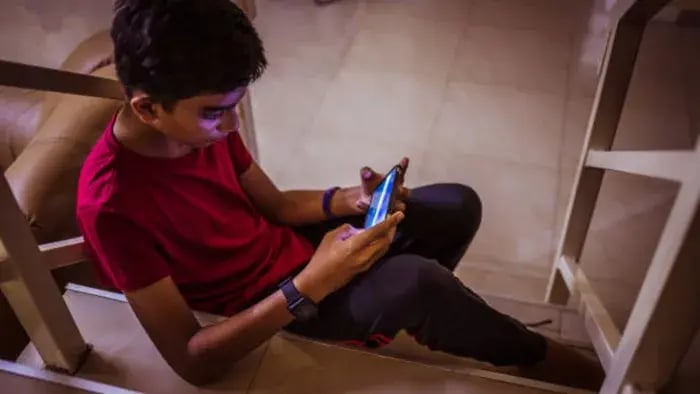- Infants (0–2 years): Keep It Minimal and Meaningful
- Toddlers and Preschoolers (2–5 years): Co-View and Guide
- Young Children (6–9 years): Balance and Routine Matter Most
- Tweens (10–12 years): Encourage Purposeful Use
- Teens (13–18 years): Focus on Balance, Not Just Time
Introduction
Screens are everywhere, on phones, tablets, TVs, and laptops, and they are a big part of how kids learn, play and connect. But with so much time spent in front of screens, parents naturally wonder: how much is too much?

For many families, screen time has become a daily juggling act. Online classes, educational videos and games can be valuable. But endless scrolling or binge-watching can quietly replace outdoor play, sleep or real-world interactions. It’s about making screen time meaningful and age-appropriate.
Healthy screen habits depend on the child’s age, purpose of use and how the rest of their day is spent. A teenager using a laptop for research or creative projects is different from a preschooler watching cartoons for hours. What matters is creating a routine where screens are just one part of a balanced day that also includes physical activity, conversations and rest.
What’s “healthy”, it s about awareness, balance and communication. When screen time is guided and mindful, it can support growth, not distract from it. Let’s look at what that balance looks like for different age groups and how families can create screen time routines that feel right.
How Much Screen Time Is Healthy for Kids and Teens in Today’s World?

Managing screen time has become one of the most common challenges for parents today. Instead of removing them completely, the goal is to understand how to include screen use in a child’s day without letting it take over.
Every age group has different needs; what works for a teenager with school projects and social chats won’t suit a preschooler who’s still learning through movement and play. It includes what children are watching, why they’re using screens, and how it fits into their lifestyle.
Infants (0–2 years): Keep It Minimal and Meaningful
At this early age, babies are learning through touch, sound, and face-to-face interaction. Screens don’t offer much to support that kind of learning. It’s best to keep screen use close to zero. If you do allow a little bit, like a short video call with family, try to be there with them and talk about what’s happening on screen. These shared moments are far more valuable than passive watching.
Toddlers and Preschoolers (2–5 years): Co-View and Guide
At this stage, young kids are full of curiosity, and some screen content can support learning new words, colors, and ideas. Limit screen time to around one hour of high-quality content per day. Most importantly, watch with your child. Ask questions, talk about the story, and connect it to real life.
Young Children (6–9 years): Balance and Routine Matter Most
Kids in this age group are starting school, building friendships, and developing hobbies. They may want more screen time for games, shows, or even learning. Set daily screen time limits (usually around 1.5 to 2 hours outside of schoolwork), but focus more on creating a healthy daily routine. Make sure screen time doesn’t replace physical play, reading, meals with family, or enough sleep.
Tweens (10–12 years): Encourage Purposeful Use
This is the age when many children begin to explore the online world more independently. They may watch videos, play multiplayer games, or use messaging apps. Limit non-educational screen time to around 2 hours a day, but also talk openly about what they’re watching or doing. Guide them to use screens for creativity, like making videos, learning music, or exploring art, rather than just passive viewing.
Teens (13–18 years): Focus on Balance, Not Just Time
Teenagers often use screens for school, social life, entertainment, and even managing stress. Instead of focusing only on time limits, look at screen habits as a whole. Are they staying active? Are they sleeping well? Are screens affecting their mood or schoolwork? If yes, help them create better boundaries, like screen-free times at night or during meals. Encourage digital breaks and talk regularly about how they feel when using social media or watching content.
Conclusion

There is no single number that fits every child when it comes to screen time. What really matters is the overall routine and how screen use fits into your child’s daily life. You don’t need to count every minute; instead, look at the whole day. Is your child playing, resting, learning, eating, talking, and sleeping well? If yes, their screen habits are probably in a healthy place. A flexible and balanced approach helps screen time become a positive tool, not a problem. With open conversations and smart routines, you can make screens a safe and useful part of your child’s growing world.
Her love for storytelling began with reading her grandfather’s speeches, where Tarishi saw the power of words in creating lasting memories. Combining her passions for food and writing, she has turned her life into a fulfilling path of sharing stories that celebrate flavours and how food brings communities together.
The views expressed are that of the expert alone.
The information provided in this content is for informational purposes only and should not be considered a substitute for professional medical advice, diagnosis, or treatment. Always seek the advice of your physician or another qualified healthcare provider before making any significant changes to your diet, exercise, or medication routines. This is a sponsored article.
















